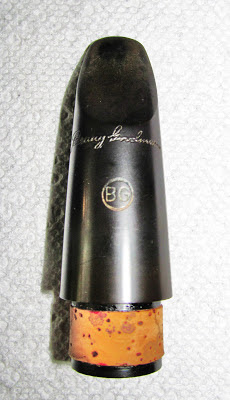 |
| Benny Goodman Model Mouthpiece by Selmer (c.1955) |
The newest addition to The Jazz Clarinet's ever expanding mouthpiece museum is a vintage Benny Goodman Model by Selmer. This piece was a particular treat for me to test drive, as my main horn is a 1955 Selmer Centered Tone, and the BG Signature (or "Circle BG" as it is also known) was undoubtedly intended to match such a clarinet.
There are various internet anecdotes regarding Benny's mouthpieces, some of them purportedly first hand accounts of testing those housed at Yale. As of this writing, I have neither seen nor played those, but the usual story is that they are rather non-descript, very open pieces that play with extremely soft reeds (Vandoren 1.5 is usually mentioned). There are many difficulties with such accounts--or with any mouthpiece reviews, for that matter, including this one. The individual playing the equipment is a profound and decisive factor concerning the 'proper' reed setup, for instance. But when faced with stories of Benny's equipment, many other questions arise, not least of which being when Benny played the mouthpiece in question. Was it the height of his jazz career from 1935-45? Was it during his switch to a double-lip embouchure under the influence of Reginald Kell in the 1950s? Or was it from his long retirement, when he divided his time between concerto performances and reunion shows? Age, repertoire, and venues all have their potential influence.
[Update as of 3/25/14: I recently read another report about Benny's mouthpieces, albeit another internet anecdote suggesting that the late Ralph Morgan measured Benny's facing and found it medium-close. Based on my own experience, I tend to agree with this].
Beyond these historical questions, the subject of this review wasn't from Benny's equipment bag, but a mouthpiece marketed by Selmer for the general public. As such it was probably not played by Goodman, but designed to give the average clarinetist a mouthpiece that might replicate, in some sense, the Goodman sound.
One of my goals for The Jazz Clarinet is to begin measuring all of the gear presented here and to update these reviews. But even without exact measurements, some unique properties of this piece are obvious on sight. This is now the longest facing of any French mouthpiece in my collection. It's even longer than many of the German pieces I own; closest to a 1951 Fritz Wurlitzer and the newer Vandoren Deutsche models. Also, like the German pieces, the facing is quite close--considerably closer than a Selmer C85 105, and the bore is considerably wider.
Playing it, I got a real jump and boom. This thing is a real bazooka; probably the loudest piece I own. Despite my penchant for medium close mouthpieces, the facing of this was a bit constraining for me, and if I ever intended to use it regularly, I'd have to have it opened up. The altissimo was by far the nicest of the registers, followed by the clarion. Both of these yielded a balanced, round, full sound without the annoying buzz that many clarinet mouthpieces give when pushed. The lower I got, though, the thinner the sound, with the chalumeau being the most challenging. Glissandi, articulation and overall flexibility were very good, considering the facing, but once again it would have to be altered to suit my needs.
I found that taking less mouthpiece in the mouth was helpful, but less comfortable for me personally. In retrospect, this might have been part of the design. I once knew student of Gino Cioffi who insisted on playing with only the very tip of the mouthpiece, and blowing through the horn like a pea-shooter. This was never an approach I liked, but the era in which these mouthpieces were made was also the golden age of Selmer in Cioffi's Boston Symphony section. Perhaps this mouthpiece was designed with that sort of classical pedagogy in mind.
Overall, this is a fascinating mouthpiece, with real potential for jazz.
[Update 3/25/14: I had this mouthpiece refaced by Bradford Behn several moths ago, and it has become my number one mouthpiece for gigs--without a 'classical' embouchure.]
